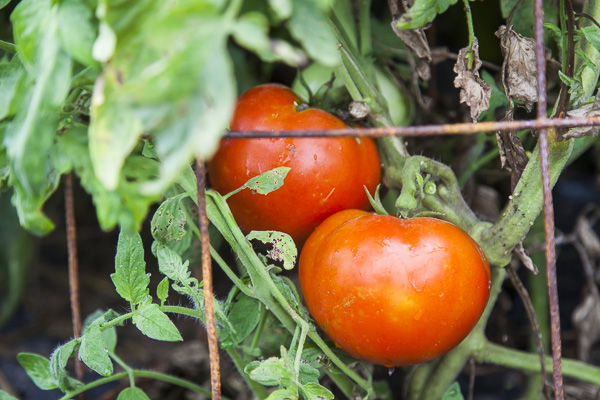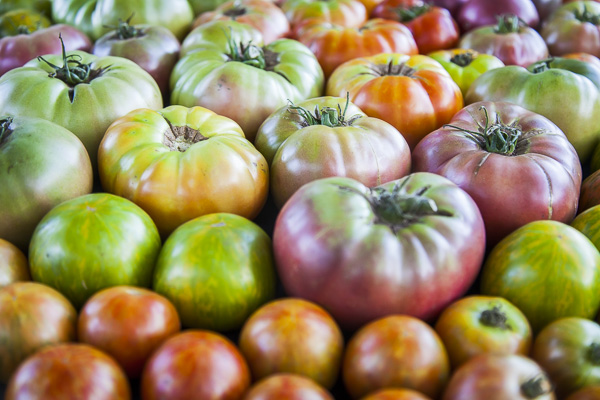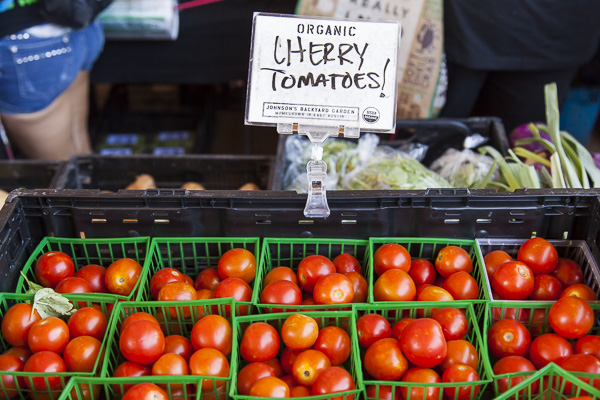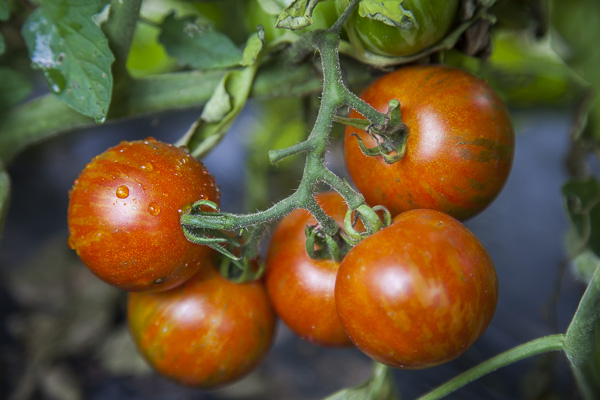
TOTALLY TOMATOES!
05/20/16 — Farm
 Photo by Scott David Gordon
Photo by Scott David Gordon
You know summer is here when... tomatoes start coming in! We wanted to write a blog post celebrating this little bundle of summer flavor - the tomato certainly has a unique and colorful history, spanning continents and centuries!We just harvested our first ripe, juicy Juliet tomatoes for the SFC Triangle Market this Wednesday, and couldn't be more excited that tomato season is finally here. So here's to you, Solanum lycopersicum, for brightening up a rainy week here at JBG.
History
Wild cultivars of the tomato originated in South America - what is today Peru, Bolivia, Chile and the other Andean nations. Native tomato plants produced small, cherry-sized fruit that likely ripened to yellow (not red!). Though it was used as a food product, the tomato was not an important crop and was one of the last Solanum family plants (other include chili peppers, potatoes, and tobacco) to be brought north to Central America during cultural migrations. To this day, a number of wild tomato cultivars can still be found growing across South America!The Aztec culture is credited with domesticating the tomato and incorporating it into their cuisine - way back in 500 BC. The tomato lived a fruitful, but quiet life until the sack of the Aztec capital Tenochtitlan by Hernan Cortez in 1521. Tomato seeds, among many other treasures, made it back to Europe following the seizing of the city. This jet-set really opened the doors for the future of tomatoes as a global food crop.

Across the Atlantic, the tomato underwent extensive breeding, most notably by the Italians, who created new varieties with all kinds of wonderful colors, shapes, and sizes - these fruits probably looked like what we call "heirlooms" today. Interestingly enough, these fruits were first bred as ornamentals, not as a food source! The first appearance of tomatoes in a European cookbook were published in Naples, Italy in 1692.
And who better to bring the glorious tomato back to America than Thomas Jefferson? The Jeffersons grew and bred tomatoes at Monticello, and along with a few other American botanists - most notably a man names Alexander Livingston, the number of tomatoes varieties around the world grew into the thousands! Jeffrey Campbell is another big player in the tomato game, making it a staple in the American household with his condensed tomato soup idea - he wanted to save money on shipping by removing some of the water weight, resulting in the iconic Campbell's Tomato Soup can.
 Photo by Scott David Gordon
Photo by Scott David Gordon
Folklore
There are loads of myths, legends, and stories centered around the tomato. The Pueblo nation believed that those who ingested the seeds of a tomato would be given powers of divination, while many people in colonial times believed tomatoes to be poisonous fruits. It was said that eating the fruit of a tomato plant would turn one's blood to acid. Sounds nasty! This misconception may have come from the fact that many toxic members of the nightshade family - mandrake, belladona, and poison nightshade - all look like their cousin, the tomato.You can't keep a good veggie down though, and by the late 16th century, tomatoes were recognized as not just nonpoisonous, but delicious! The tomato earned a reputation as an aphrodisiac, with nicknames such as pomme d'amour - French for "love apple." In the 1920s, beautiful women were sometimes referred to by the slang phrase "hot tomato."
 Photo by Scott David Gordon
Photo by Scott David Gordon
Heirlooms, Hybrids, and more!
With literally thousands of cultivars all over the world, how does one decide how to grow the best tomato? Heirloom tomatoes are famous for having much better flavor (and beautiful shapes and colors) compared with most commercial varieties. Why is that? A natural gene mutation resulted in the "u" gene - u for uniformly ripening. Once discovered, it was bred into some commercial varieties for that perfect, all-red tomato you see at big-box grocery stores that taste like cardboard. Unfortunately, tomatoes with this trait also produce less sugar, by about 10-15%.Luckily, lots of tomatoes with better flavor exist - in reds, purples, yellows and more! If you want to save seed from your home tomatoes, be sure to get an heirloom, or at least an "open-pollinated" variety, as their offspring will look the same as the parent plant. If you buy new seeds from year to year, also consider browsing hybrid varieties - botanists cross-pollinate tomatoes to produce varieties with amazing traits - flavor, sweetness, vigorous growth, disease resistance and more. Some breeders are currently working on increasing disease resistance by hybridizing modern-day favorites with wild Andean cultivars - a plant's way of saying that [great-great-great-great-great-great-great-grand-]mother knows best!
Bonnie Plants has a great explanation of the differences between heirlooms, hybrids, and genetically modified varieties that's worth a read.
Heirloom Varieties:
- Cherokee Purple (read NPR's story of this tomato!)
- Yellow Pear - a gorgeous cherry
- Striped German - big, yellow and red beefsteak
- Amish Paste - the best sauce tomato
- Sungold - everyone's favorite cherry.
- Big Beef - a red hybrid tomato that has definitely been bred for great flavor!
- Lemon Boy - cute, round salad tomatoes in a great shade of yellow
 Photo by Scott David Gordon
Photo by Scott David Gordon
Fun Facts
Why do we call tomatoes a vegetable, when they are really a fruit? You might blame the Supreme Court - in 1887, Nix v. Hedden determined that tomatoes should be subject to the 10% vegetable tariff that importer John Nix was protesting by importing this exotic "fruit".In Arkansas, the tomato is both the state fruit AND the state vegetable!
Those hairs on the stems of your tomatoes? Each one has the potential to turn into a root if the stem is placed on the ground. This is why gardeners are encouraged to plant their tomatoes deep.
The town of Buñol, Spain, hosts an annual festival culminating in a giant tomato fight, called La Tomatina.
 Photo by Scott David Gordon
Photo by Scott David Gordon
Be on the look out the week of June 1st for our annual Tomato Sale to get rolling! We'd love to hear what you're planning on doing with this year's bounty - sauces? Salsa? Chutney? Let us know! And let's all hope this rain slows up - we need the heat units to ripen up these tomatoes, stat!






 0 ITEMS IN CART
0 ITEMS IN CART 

